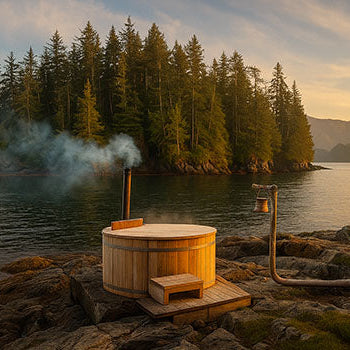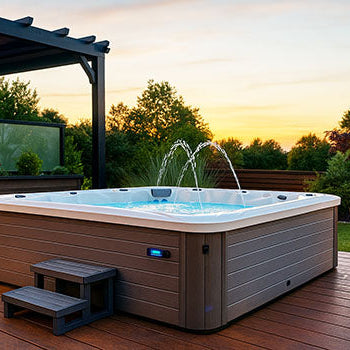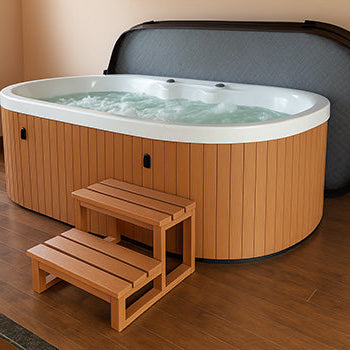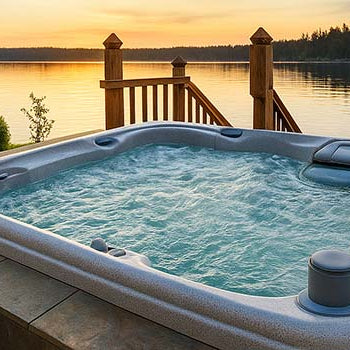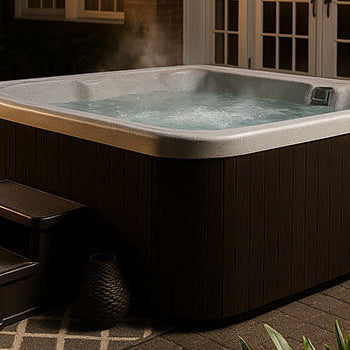Under a tree? Too messy. On a slope? Risky. Right by your fence? Neighbour complaints incoming.
The worst place to put a hot tub is anywhere unstable, exposed, or awkward.
Some hot tub owners stick an Acrylic Hot Tub in direct sunlight and wonder why the shell fades. Others set up Rotomoulded Hot Tubs on soft lawns and end up knee-deep in mud. Even Wooden Hot Tubs, charming as they are, won’t last long on soggy soil.
If you’re dreaming of stress-free soaks, placement matters more than you think. Let’s run through all the spots you should avoid, so your hot tub doesn’t become a hot mess.

The Critical Importance of Correct Hot Tub Placement
Ensuring Safety (Structural, Electrical, User Access)
Hot tubs are heavy, even before you add water and people. Placing one on uneven or unstable ground can lead to cracks, tilting, or worse, structural failure.
Think about how you’ll get in and out. If it’s a tight squeeze, or you’re stepping onto wet grass or wobbly pavers, you’re just one slip away from a bruised shin (or ego).
And don’t forget electrical safety. Water and power don’t mix, so your setup should follow all local safety guidelines.
Protecting Your Hot Tub and Property from Damage
A badly placed hot tub doesn’t just affect your spa, it can damage your home. Imagine water runoff seeping into your foundations, or cover straps snapping from wind tunnels created by bad positioning.
Branches can fall. Debris clogs filters. And if you’re constantly scooping out leaves, the ‘relaxation’ part gets old real quick.
Poor placement means more cleaning, higher repair bills, and faster wear and tear. Not ideal.
Maximising Convenience and Enjoyment
If your hot tub feels like a chore to reach, you’ll use it less. If it’s boxed in, exposed to neighbours, or awkward to clean around, the fun fades fast.
A good location means you can slip in any time, with privacy, comfort, and a towel close by.
The more convenient the spot, the more you’ll enjoy your investment.
Outdoor Locations to Steer Clear Of
Uneven, Sloping, or Unstable Ground
Your hot tub isn’t a hammock. It needs a solid, level surface.
If the ground shifts, sinks, or slopes, it can cause structural strain and water displacement.
Worse, the stress might crack the shell or knock components out of alignment. Not only is it dangerous, but it can void your warranty, too.
Directly Onto Lawn or Soil Without a Proper Base
Sure, placing your hot tub on the grass seems simple. But give it a few weeks, and that lush lawn turns into a muddy crater.
Soil shifts under weight. Water collects underneath. Bugs move in.
Always install your hot tub on a hard, level base, like paving slabs, concrete, or reinforced decking.
Low-Lying Areas Susceptible to Flooding or Poor Drainage
If your chosen spot turns into a pond after rain, rethink fast.
Floodwater can get into pumps and controls, while stagnant puddles make for a soggy, slippery mess.
Keep your hot tub on high ground, away from known runoff zones. You want water to flow away from your spa, not into it.
Immediately Under Large Trees or Overhanging Branches
That shady tree might look peaceful, but it’s secretly plotting.
Leaves, twigs, bird droppings, and even falling branches can damage your hot tub’s cover, or worse, crack the shell during storms.
Tree debris means extra cleaning, extra costs, and less time relaxing. Keep your spa a safe distance from overhangs.
Close Proximity to Overhead Electrical Lines
This one’s a big no. Not only is it a serious safety risk, but it’s often against local regulations.
Water plus overhead electrical cables? You don’t need to be an electrician to see the problem.
Always check clearance rules and consult a professional if you’re unsure.
Areas Impeding Access to Maintenance Panels
Your hot tub has vital components like pumps and filters tucked behind panels. Block those, and every repair turns into a nightmare.
Leave at least 60cm of space around the access side, and don’t wedge the tub between fences or walls. You’ll thank yourself later.

Indoor Installation: Potential Problems to Address
Insufficient Ventilation Leading to Moisture Issues (Mould, Mildew)
Hot tubs indoors? Sounds luxurious, until your walls start sweating.
Steam builds fast and settles into corners, especially in enclosed rooms.
Without proper airflow, you’re asking for mould, mildew, and long-term damage. Install strong ventilation or a dehumidifier system if you’re going this route.
Inadequate Structural Support for the Floor
Even a small tub can weigh over a tonne when filled.
Installing one on an upper floor, balcony, or old timber base without reinforcement is risky.
Always check the floor’s load-bearing capacity, and if unsure, consult a structural engineer before moving forward.
Lack of Suitable Drainage Provision
Spills happen. Full drains are a must.
Without proper drainage, water damage becomes a real risk, especially indoors.
A nearby floor drain or water-safe surface is essential, not optional.
Practical Difficulties with Filling and Chemical Use Indoors
How will you fill it? Where do you store chemicals?
Indoor setups often lack a nearby hose connection or a well-ventilated storage spot.
Chemical fumes can linger and create a health hazard, especially in closed spaces. Think carefully about logistics before going indoors.
Other Placement Mistakes to Avoid
Locations Offering Zero Privacy
No one wants to wave at the neighbours mid-soak.
A hot tub with no privacy feels exposed and awkward, which means you’ll use it less.
Install fencing, hedges, or privacy screens, so you can relax without worrying who’s watching.
Sites Exposed to Strong Prevailing Winds
Windy spots cool your tub faster, make covers flap, and send leaves flying in.
Worse, it can raise your energy bills and chill you to the bone during winter dips.
Use your garden layout or a windbreak to shield your space from the breeze.
Spots That Are Too Inconvenient to Access Regularly
If your hot tub is across the lawn, past the garden hose, behind the shed... will you use it on a chilly evening?
Probably not.
Choose a location that’s close, accessible, and easy to walk to, especially in bare feet.
Identifying a Suitable Location: Key Criteria
A Solid, Level, and Stable Foundation is Paramount
It doesn’t matter if it’s a Wooden Hot Tub, Rotomoulded spa, or premium Acrylic model; every tub needs a sturdy base.
Cracks, leaks, and motor strain often start from unstable foundations.
Use reinforced decking, concrete pads, or tightly packed pavers.
Adequate Drainage Away from Buildings
Water should always flow away from your home, not toward it.
Poor drainage can damage brickwork, create mould, and ruin patios.
A simple slope in the right direction can save you from major repairs.
Sufficient Clearance for Use, Cover Removal, and Maintenance
Can the lid open fully? Can you walk around the tub comfortably?
If not, it’s too cramped.
Leave space for movement, servicing, and safe cover handling. You’ll enjoy it more when it feels open and easy to use.
Safe and Practical Access to Electrical Supply
No DIY jobs here. Your hot tub needs a dedicated, professionally installed power supply.
Running cables across the lawn isn’t just ugly, it’s dangerous.
Plan your electrical access before you place the tub.

Conclusion: Planning Your Placement Prevents Future Headaches
A hot tub is only as good as the spot you put it in.
The wrong location can lead to endless cleaning, costly damage, and awkward use.
But with smart planning, you can turn your garden into a five-star retreat.
Focus on stable ground, proper drainage, privacy, and safety.
Whether you’re setting up an Acrylic spa near your patio or placing a Wooden tub under the stars, get the location right from the start.
Your future self: relaxed, warm, and smiling, will be glad you did.
